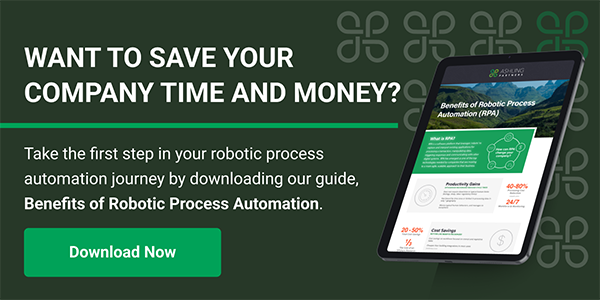The views reflected in this article about RPA platforms are solely those of the author, and do not necessarily reflect the opinions of Ashling Partners.
RPA is becoming one of the most sought out technologies; businesses across industries are looking to it to improve their efficiency across operations while providing a strong ROI. I strongly believe once you have experienced the power of RPA platforms, you will see the opportunities in your business sector in a very different way and think most of about ways that much of the boring work that you are doing today can by automated, and even more importantly, much of the value-added work you always wanted to do can now be taken on. In your quest to understand what RPA is and how you can integrate it into the existing processes, I will try to illustrate why you need RPA and how it can be beneficial to your organization.
What is RPA?
RPA refers to developing a software that automates manual human tasks, increasing accuracy by reducing human errors, and increasing efficiency and speed of the process. The main objective of an RPA platform is to ease your employees from performing highly monotonous, mundane and repetitive tasks, and allowing them to use that valuable time to work on more purposeful and knowledgeable tasks.
Identifying the processes to automate
The technology of RPA has been growing at a significant rate and you can now automate processes that were not possible even 2 years ago, like processes involving unstructured data. The following processes along with many others will be ideal to integrate RPA:
- Rule -based processes
- Manual Data entry tasks
- SAP Automation
- High-Volume, repetitive tasks
- Data Validation
Automation options
Now, the question arises, which tool do we use to implement RPA? There are many RPA platforms out there in the market that each have their own benefits. UiPath, Automation Anywhere and Blue Prism are what you can call the ‘Big 3’. Without going into too many technical details, I will try to explain some details about these 3 and why you can’t go wrong choosing either of them. In no particular order:
Blue Prism
Blue Prism is one of the most mature RPA tools, and one of the most widely used in the organizations. Blue Prism scores best when It comes to governance and security. Although most of the automation tools require little to no programming skills, Blue Prism requires good C# programming knowledge compared to other RPA tools and it has its both advantages and disadvantages. You can’t really go wrong when automation implementation can be done using coding.
Now, coming to the cons, Blue Prism is a bit complex to learn and can be difficult to fully understand for beginners. Blue Prism does not have a free or trial version and has limited training resources.
Blue Prism is more rigid in general compared to other tools and has client-based servers, that means it can be accessible only through Blue Prism applications. Blue Prism is ideal if you want to build more complex solutions but for simple rule-based processes and ease of learning, other automation tools work better.
UiPath
UiPath has seen tremendous growth over the last year and has been talk of the town recently for all the right reasons.
First and foremost, UiPath offers robust education options online. For beginners who want to get engaged with RPA, I would say there is no better learning platform than UiPath. It is extremely user friendly and is flexible as it allows the solutions to be hosted anywhere on client premises, BPO Partner’s servers or public clouds such as Microsoft Azure. The robots created using UiPath can dynamically allocate work according to changing workload and priority requirements.
UiPath’s Orchestrator, from where you can oversee your workflows and manage, is one of, if not the best in business. It has features like work queues and advanced scheduling options to help run the workflow efficiently. You can control and view log reports, schedule a task and handle exceptions from here. Orchestrator is web based unlike Blue Prism’s control room and can be accessed from any browser and even your mobile.
UiPath has recently launched a platform UiPath Go! where users can share the components they have built with the community. Reusable components and snippets can be downloaded and can be used right away without having to invest any time in developing something that is widely re-used e.g. logging in and logging out of SAP
UiPath’s lack of better debugging features compared to Blue Prism and Automation Anywhere and their lack of integration with GitHub are the main disadvantages, both which they are planning to add in their future updates.
For ease of use, great learning experience, quick implementation and low development cost UiPath is the way to go.
Automation Anywhere
Automation Anywhere (AA) is also among the most popular RPA platforms and has had the most market presence over the last several years. Automation Anywhere is an easy-to-learn tool with drag and drop functionality for most of the activities.
Automation Anywhere, like UiPath, has a Bot Store where a user can download the bot workflows and components. Automation Anywhere’s debugging feature is one of the best compared to its competitors as you can selectively choose parts of your workflow to test. The main feature of AA that helps it stand among the other RPA Tools is that it provides real time monitoring of the analytics and ROI with their platform ‘Bot Insight’. One can constantly monitor the efficiency and effectiveness of and easily determine in real time the operational performance and monitor ROI.
But, AA’s lack of integration with other OCR technologies means a higher cost of deployment and its handling of multiple number of robots simultaneously is not as stable as one would want it to be. AA does have IQ Bots that includes OCR technology, but we have found the cost to be significant for the investment and roll out. AA is also not a free to learn software and has limited learning resources available online.
To conclude, every tool has its pros and cons. At Ashling Partners, work closely with you to try to identify the ideal tool and help you select the software as per your needs and resources. We try to identify and understand the business requirements of the process and have the expertise needed to take it forward and lay out a successful foundation to integrate automation within your organization.



